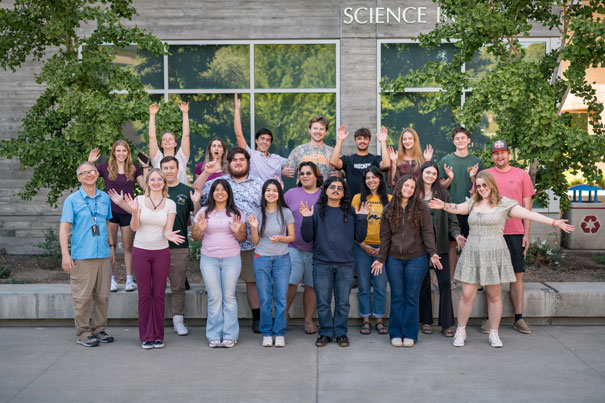Welcome to the ERTH 440, Environmental Sensing, webpage for the Fall 2025 semester.

Fall 2025 ERTH 440 class on 9/23/2025. Photo by Jason Halley.
This page will be updated every few days as the course progresses...
Required book: Meteorological Measurement and Instrumentation by Giles R. Harrison, (c)2015.
Link to on-line library version (requires csuchico.edu connection).
Link to Publisher.
Aug. 25, Mon., Lecture: Review syllabus, and start with basic vocabulary in instruments.
Aug. 26: Tues.: Lab #1: Using Arduinos to blink LEDs and sensing temperature from a TMP36.
Aug. 27, Weds., Lecture: Begin Chapter 2: parameter, sensor, transducer, amplifier, meter, recorder, analog, digital, binary, begin ADC.
Sept. 1, Mon.: Labor day. Campus closed.
Sept. 2, Tues.: Lab #2: Using a voltage divider and a thermistor to measure temperature.
Sept. 3, Weds.: Lecture: Analog to digital conversion, resolution, sensitivity, linearity, dynamic range, and response time.
Sept. 8, Mon.: Lecture: Systematic and random errors. Accuracy and precision. Then, Newton's law of cooling and response time.
Sept. 9, Tues.: Lab #3: Learning how to solder and soldering pins on data shield.
Sept. 10, Weds.: Lecture: Quiz #1. Then, conclude response time and begin temperature and thermometers (Chapter 5 in book).
Sept. 15, Mon.: Lecture: discussion of term project teams and ideas.
Sept. 16, Tues.: Lab #4: Setting the real-time clock and programming your Arduino and data shield to save date, time, and temperature.
Sept. 17, Weds.: Lecture: Early thermometers. Solid-stem liquid-in-glass thermometers. Reference environment and instrument. Calibration. Shelters and siting.
Sept. 22, Mon.: Lecture: The diurnal cycle and max/min thermometers, bimetallic strips, and electronic temperature sensors: diode, thermistors, thermocouples, and metal RTDs.
Sept. 23, Tues.: Lab #5: Characterizing the performance of a thermistor and 14-bit ADC system. Accuracy, precision, resolution, response time in ice and steam.
Sept. 24, Weds.: Lecture: Temperature probe shields, radiation errors, then discussion about computer issues: path, filename, slashes, and important points about time series data.
Sept. 29, Mon.: Lecture: Quiz #2 on temperature and thermometers. Then begin radiaton and radiometers. EM spectrum and ionizing radiation.
Sept. 30, Tues.: Lab #6: Complete lab #4. Discuss term projects.
Oct. 1, Weds.: Lecture: The nature of blackbody radiation (Planck function, solar, terrestrial, etc.) Begin solar radiation measurements with Campbell-Stokes sunshine recorder.
Oct. 6, Mon.: Lecture: Radiation sensors: Crookes, photoresistors, photodiodes, APDs, photomultiplier tubes, and thermopiles. Pyranometers, PAR sensors, and albedometers.
Oct. 7, Tues.: Lab #7: Digital communications via I2C sensors. Logging T and RH data with a SHTC3 sensor and making dual axis graphs in MATLAB.
Oct. 8, Weds.: Lecture: Scattering, direct and diffuse radiation, pyrheliometer, then focus on the IR: bolometers, silicon as a filter, and pyrgeometers.
Oct. 13, Mon.: Lecture: Quiz #3 on Radiation and radiometers. Lecture: Begin Chapter 6 on Humidity (water vapor).
Oct. 14, Tues.: Lab #8: First lab focused on student term projects.
Oct. 15, Weds.: Lecture:
Oct. 20, Mon.: Lecture:
Oct. 21, Tues.: Lab #9:
Oct. 22, Weds.: Lecture:
Oct. 27, Mon.: Lecture:
Oct. 28, Tues.: Lab #10:
Oct. 29, Weds.: Lecture:
Nov. 3, Mon.: Lecture:
Nov. 4, Tues.: Lab #11:
Nov. 5, Weds.: Lecture:
Nov. 10, Mon.: Lecture:
Nov. 11, Tues.: Campus closed for Veterans Day
Nov. 12, Weds.: Lecture:
Nov. 17, Mon.: Lecture:
Nov. 18, Tues.: Lab #12:
Nov. 19, Weds.: Lecture:
Nov. 24, Mon.: Campus closed for Thanksgiving holiday
Nov. 25, Tues.: Campus closed for Thanksgiving holiday
Nov. 26, Weds.: Campus closed for Thanksgiving holiday
Dec. 1, Mon.: Lecture:
Dec. 2, Tues.: Lab #13:
Dec. 3, Weds.: Lecture:
Dec. 8, Mon.: Lecture:
Dec. 9, Tues.: Lab #14:
Dec. 10, Weds.: Lecture:
Dec. 15, Mon.: Lecture: Final exam week begins
Dr. Mayor's page
